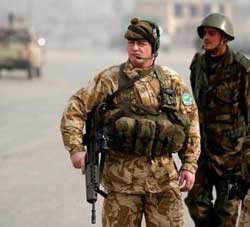US stages largest operation Vs. Taliban
( 2003-12-09 08:56) (Agencies)
The U.S. military on Monday announced its largest-ever offensive against defiant Taliban and al-Qaeda militants, sending 2,000 troops into a vast lawless swath of the south and east of the country.
 |
| Two British soldiers of the International Security Assistance Force (ISAF) patrol with an Afghan soldier in Kabul, Afghanistan, Monday, Dec. 8, 2003. [AP] |
The operation began as Afghan and U.N. officials warned that one of the military's most tragic blunders — the weekend killing of nine children in a bungled airstrike — could drive more Afghans into the arms of the rebels.
Operation Avalanche "is the largest we have ever designed," Lt. Col. Bryan Hilferty told reporters at the coalition military headquarters at Bagram, north of the capital Kabul. The enemy "isn't going to know when we hit, he isn't going to know what we're doing."
"Right now, I'd say there's four infantry battalions involved" of around 500 men each, Hilferty said. Some Afghan National Army and militia forces also will be involved, he said.
Hilferty gave no other details about the operation, including when it started or what specific provinces it was targeting.
Taliban fighters have stepped up attacks — particularly against aid workers and civilians — in provinces near the Pakistani border and in Ghazni and Zabul provinces south of the capital. A French U.N. worker was gunned down last month and three international workers were kidnapped in past weeks.
On Monday, one Pakistani engineer was shot dead and another disappeared after gunmen attacked their vehicle on the main Kabul-Kandahar highway in eastern Afghanistan.
But Saturday's airstrike — which targeted a local Taliban militant but also killed children playing in a village in Ghazni province — highlighted the risk that a heavy U.S. military hand may only alienate Afghan civilians.
"Every innocent who is killed has brothers, uncles, sisters and nephews — and behind them the tribe," said Sadokhan Ambarkhil, deputy governor of Paktika, one of the most dangerous provinces for coalition troops and their Afghan allies. "If 10 people are killed, how many people are saddened?"
The warplane attack also was criticized outside Afghanistan.
U.N. Secretary-General Kofi Annan was "profoundly saddened" by the children's deaths and called for a thorough investigation. "The fight against terrorism cannot be won at the expense of innocent lives," Fred Eckhard, Annan's spokesman, said in New York.
Seven boys and two girls, the oldest age 12, died when the A-10 warplane sprayed a dusty field with 30mm high-explosive rounds in Hutala village, 150 miles southwest of Kabul, the Afghan capital.
The attack also killed a man that U.S. officials say was Mullah Wazir, a former district Taliban commander suspected of attacking aid groups and workers on the Kabul-Kandahar road — a top U.S.-funded reconstruction project.
But villagers say the dead man was Abdul Hamid, a laborer in his 20s who had returned from Iran just days before his death, and that Mullah Wazir cleared out days before.
Residents and local officials suggested the Americans were fed bogus intelligence — a suspected cause of earlier deadly bombings of civilians — and criticized what they called a careless use of military might.
"I don't know why the U.S. forces did this," said Khial Mohammad, the deputy governor of Ghazni province, where the attack took place. "Mullah Wazir wasn't there. He's not a famous commander, but he is famous for smuggling."
Hilferty, the coalition spokesman, said DNA was taken from the scene to try to prove the strike had hit its target.
On Monday, at a briefing at the U.S. military headquarters in Bagram, north of Kabul, Hilferty said only that "we're still working on identifying him."
Aware of the damage such incidents can do to their own image, senior U.S. officers flew into the village on Sunday to offer condolences and help.
"Such mistakes could make the Afghan people think ill of the coalition," Hilferty said.
U.S. officials insist they had prepared the attack carefully and were unaware of the children when the order was given to fire.
The wave of Taliban attacks against aid workers, U.S. soldiers and Afghan government officials has belied American claims that it is winning the war to stabilize the country.
Two years after the fall of the Taliban, some 11,700 mostly American soldiers are still on combat missions in Afghanistan against the Taliban and their allies: al-Qaeda remnants and followers of renegade warlord Gulbuddin Hekmatyar.
The push announced Monday follows Operation Mountain Resolve, which involved about 1,000 troops to stabilize a remote northeastern region bordering Pakistan. That operation, which was launched Nov. 7 and ended this weekend, saw only minor skirmishes.
In March 2002, about 2,000 American and Afghan forces combined to take part in Operation Anaconda, the previous largest offensive.
|

